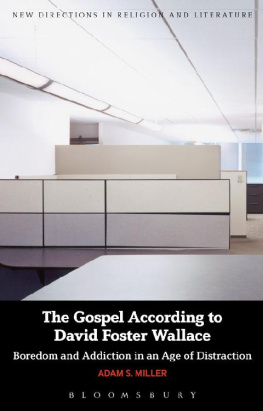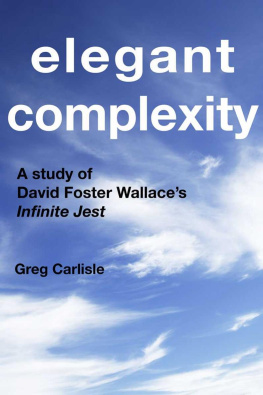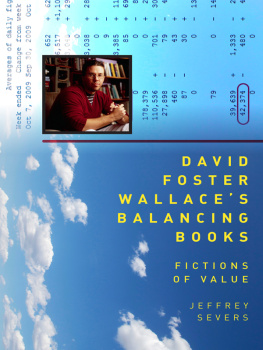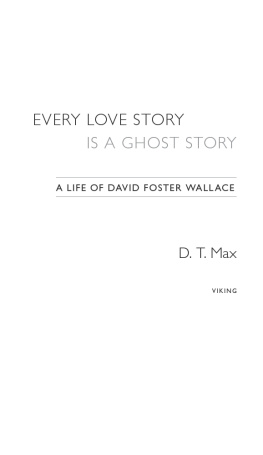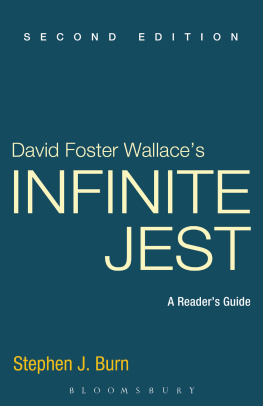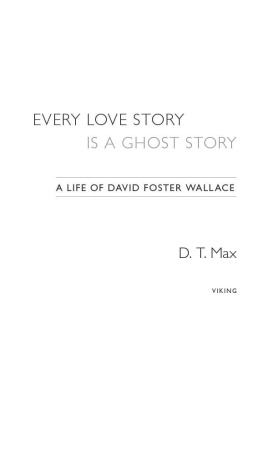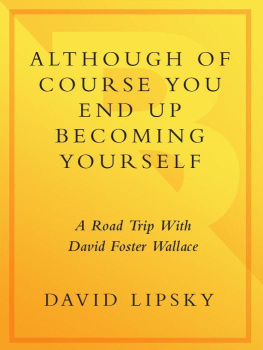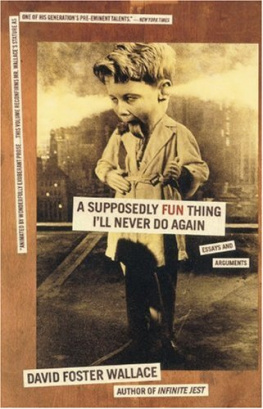David Foster Wallaces Infinite Jest
Second Edition
David Foster Wallaces Infinite Jest
A Readers Guide
S econd Edition
Stephen J. Burn

Continuum International Publishing Group
The Tower Building | 80 Maiden Lane |
11 York Road | Suite 704 |
London | New York |
SE1 7NX | NY 10038 |
www.continuumbooks.com
Stephen J. Burn 2012
First edition published 2003
Revised and expanded second edition published 2012
All rights reserved. No part of this book may be reproduced, stored in a retrieval system, or transmitted, in any form or by any means, electronic, mechanical, photocopying, recording, or otherwise, without the permission of the publishers.
e-ISBN: 978-1-4411-8632-4
Library of Congress Cataloging-in-Publication Data
Burn, Stephen.
David Foster Wallaces Infinite jest: a readers guide/Stephen J. Burn. 2nd ed.
p. cm.
Includes bibliographical references and index.
ISBN-13: 978-1-4411-5707-2 (pbk.: alk. paper)
ISBN-10: 1-4411-5707-7 (pbk.: alk. paper)
1. Wallace, David Foster. Infinite jest. I. Title. II. Title: Infinite jest.
PS3573.A425635I5433 2012
813.54dc23
2011046831
Typeset by Deanta Global Publishing Services, Chennai, India
REPRINT PERMISSIONS
Infinite Jest and the Twentieth Century: David Foster Wallaces Legacy, Copyright 2009 The Johns Hopkins University Press. This article first appeared in MODERNISM/MODERNITY , Volume 16, Issue 1, 2009, pages 1219
The Machine-Language of the Muscles: Reading, Sport, and the Self in Infinite Jest , Upon Further Review: Sports in American Literature , Ed. Michael Cocchiarale and Scott D. Emmert. Copyright 2004 by Michael Cocchiarale and Scott D. Emmert. All rights reserved. Reproduced with permission of ABC-CLIO, LLC, Santa Barbara, CA.
CONTENTS
The first edition of this book was written in happier circumstances than the second. While I had been writing about David Foster Wallace since the late 1990s, the first edition was mostly drafted in 2002, when I was living in the north of England where nobody seemed to have heard of Wallaceat least no one I knew. Working in what felt like isolation, I wrote the book out of an evangelical zeal to share his work with as many people as possible. It was published in May 2003, and shortly afterwards Marshall Boswells fine study, Understanding David Foster Wallace , appeared thus helping to spread the word about Wallaces work perhaps especially in academic circles. When the two volumes were reviewed in the Review of Contemporary Fiction , however, Robert McLaughlin identified a drawback to both studies: since these two books have been published, McLaughlin noted, Wallace has published two more books himself. We scholars of contemporary fiction just have to face the fact that Wallace can write faster than we can. Yet facing this fact was precisely what made the first edition of this book a happier occasion than the secondwhat better challenge can a literary critic face than the continued productivity of his or her chosen author?
While the second edition emerges out of the darkness that follows Wallaces death, it also appears in a world where Wallaces critical star has ascended and his raised profile requires a number of revisions to the original volume. Many of the components of the first edition were stipulated by the format of the Continuum Contemporaries series in which this volume first appeared: an introductory biographical sketch, a brief survey of reviews and early criticism. But while these elements were appropriate a decade ago, they are now largely redundant, in part because there are entire essays dedicated to surveying Wallaces critical reception (such as Adam Kellys David Foster Wallace: The Death of the Author and the Birth of a Discipline), but also because of the multimodal nature of Wallace criticism today: in recent years, in addition to three other introductory volumes and a growing body of academic criticism, web-based models of distributed reading such as Infinite Summer (www.infinitesummer.org) and Sam Pottss visual mapping of the novels characters (sampottsinc.com/ij/) have all offered alternative entry points to Infinite Jest . Without the current need for basic introductory matter, I have removed four of the first editions five chapters, leaving just the long second chapter, which originally composed more than half of the book, and which appears now in expanded form as chapter three. Apart from adding a new discussionabout tennis and readingto the end of this chapter, it is only slightly different from its earlier incarnation, though I have inserted endnotes to the chapter that reflect the opening of the Wallace archive in Texas, the publication of The Pale King , and the expansion of Wallace scholarship over the intervening period. Supplementing this central discussion are two new chapters and an epilogue.
The first edition of this book offered, in essence, a modernist reading of a post-postmodern novelconcentrating on the treatment of time, identity, mythic parallels, the existence of order beneath apparent disorderand as such it was informed by a series of assumptions, in part, about the suprahistorical nature of encyclopedic texts such as Infinite Jest . In a book I published in 2008 Jonathan Franzen at the End of Postmodernism , which is to some extent a companion volume to this Wallace guideI tried to reverse my approach, and studied Wallace and several other major members of his generation (Franzen, Richard Powers) from the opposite direction, concentrating on the emergence of post-postmodernism in the mid-1990s. In the two new chapters I have added to this revised edition I have tried to bring both perspectives to bear on Wallaces work. While this longer book does not pretend to offer a comprehensive reading of Wallaces total body of work, by adding new material I havewhile remaining focused on Infinite Jest consciously tried to counter certain strands of Wallace criticism that tend toward too narrow a view of both Wallaces fiction and the complex literary field that his work reciprocally drew upon and impacted. As early as 2000, Frank Cioffi had noted that the novel inspired obsessive behavior in its readers (180n. 7), and perhaps because of this tendency Wallace criticism, for all its insights to date, has (understandably) often focused quite narrowly upon a single Wallace worknearly always Infinite Jest and rarely engaged sufficiently with more than a single ancestor text or contemporary work. The counterargument that underlies the new material in this volume is that a reader can gain a richer sense of Wallaces achievement in Infinite Jest by sidestepping the atomistic tendency of many studies in favor of putting the novel back into a larger literary and cultural matrix. The tendency of the first two chapters, then, is largely centrifugal: the first chapter works from the assumption that in the longer view a full measure of a writers significance is not solely bound between the covers of his novels; it also lies in the way that writers influence becomes entwined in the contemporary novels DNA. Working from this principle, I try to assess Wallaces influence upon his post-postmodern contemporaries in a fashion that simultaneously feeds back into and enriches our understanding of Wallaces work itself. Moving from the opposite direction, the second chapter outlines part of Wallaces novelistic genealogy, but it does so by first articulatingthrough a reading of the microfiction A Radically Condensed History of Postindustrial Lifethe layered aesthetic that underlies much of his work. A common thread running through both chapters is the need for Wallace criticism to grow beyondwithout necessarily entirely rejectingits early entanglement in the indisputably important essay E Unibus Pluram through a more nuanced sense of Wallaces work and the literary past. The evidence of Wallace conferences such as Toon Staess Work in Process suggest that this growth is already underway.
Next page

